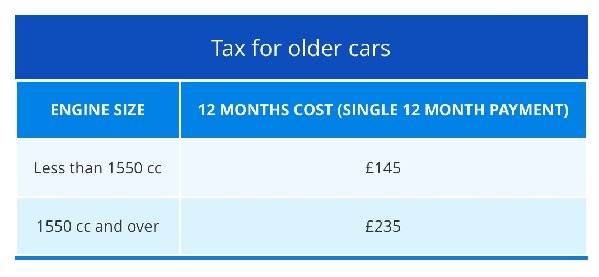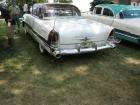|
Re: Small export engine for 120?
|
||||
|---|---|---|---|---|
|
Forum Ambassador
|
Very interesting.
By my calculations, with a 2 & 7/8" bore a 120 Packard would be rated at 25.9 horsepower and with a 3 & 1/4" bore would be rated at 33.8 horsepower.
Posted on: 2018/10/30 21:59
|
|||
|
Mal
/o[]o\ ====  Bowral, Southern Highlands of NSW, Australia "Out of chaos comes order" - Nietzsche. 1938 Eight Touring Sedan - SOLD 1941 One-Twenty Club Coupe - SOLD 1948 Super Eight Limo, chassis RHD - SOLD 1950 Eight Touring Sedan - SOLD What's this?  Put your Packard in the Packard Vehicle Registry! Here's how! Any questions - PM or email me at ozstatman@gmail.com |
||||
|
||||
|
Re: Small export engine for 120?
|
||||
|---|---|---|---|---|
|
Home away from home
|
This is a very interesting topic as Ozstatman said and this leads to different trains of thought. Such as tariffs, sales expectations, fuel economy, compatibility with metric sizing etc. WWI had ended many years before and most of the world was in the depression era.
I'm sure "Petrol" was difficult to obtain in many places around the world. What was available was probably expensive during that time. Maybe fuel consumption was a big selling point? I recall in the 60's (as an example) a large influx of small bore engines entering the US, Renault, MG, Toyota, Datsun (we had a '62 Pick up, tiny) to name a few. These small bore engines had a difficult time keeping up with our road infrastructure. Would a smaller engine be better for the roads they had at the time? As stated there is a smaller bore engine, what about gearing/ transmissions? Carburation? Would a smaller bore engine require a different carb or gear ratios? I would bet many of those cars were reused as war material for WWII and would be extremely difficult to find. I wonder if there is any printed information such as brochures or patents in files in Europe and other countries?
Posted on: 2018/10/31 9:36
|
|||
|
[url=http://packardinf
|
||||
|
||||
|
Re: Small export engine for 120?
|
||||
|---|---|---|---|---|
|
Forum Ambassador
|
I am curious about the performance aspect of the smaller engines and how they fared. I suspect the majority of European roads of the time were narrow, twisty and could handle nowhere near the speed limits we were used to but still the smaller engines trying to move a large American car would seem to be asking a lot. Even some of the engines over here were maxed out at regular sizes. Wondering for a European buyer who was contemplating a purchase, did performance ever enter into the decision or was it only about the taxes? What kind of money was involved and were the large engines permitted if someone did want one?
Posted on: 2018/10/31 9:50
|
|||
|
Howard
|
||||
|
||||
|
Re: Small export engine for 120?
|
||||
|---|---|---|---|---|
|
Forum Ambassador

|
Howard, you, DAF, and others respond as if this small engine was a reality and was actually built and supplied in export 1935 120s. I'm still doubtful, does anyone have any proof that this smaller engine actually ever reached production?
Posted on: 2018/10/31 10:30
|
|||
|
||||
|
Re: Small export engine for 120?
|
||||
|---|---|---|---|---|
|
Forum Ambassador
|
I don't know that the engine was produced. I was mostly just curious how smaller version engines in general worked in Europe with the large American cars that did have them when even regular US production engines in the same model could be marginal. Were the taxes so high that customers who opted for an import just had to put up with maybe poor performance or were there reasonable cost options.
It was mentioned the average European small engined cars did not fare well here in wide open spaces and that was on a smaller lightweight car. Wondered about the reverse with a large heavy car with maybe not great performance on a typical European road. I remember riding in a VW Beetle with maybe 30 or 40 hp going up Waldo grade near San Francisco. By the time we got to the top it would almost have been quicker to get out and walk so can just imagine what a large car would do in similar situation with a small engine.
Posted on: 2018/10/31 11:57
|
|||
|
Howard
|
||||
|
||||
|
Re: Small export engine for 120?
|
||||
|---|---|---|---|---|
|
Home away from home
|
Not presuming that such an engine existed, the UK does tax on CC displacement for older vehicles (pre-2001) rather than on horsepower although they currently tax on emissions levels. I don't know what they were doing in the '50s but I am told that it was also by displacement.
Posted on: 2018/10/31 14:01
|
|||
|
All generalities are false.
Once I thought I was wrong but I was mistaken. Don Pierson Packard / IMPERIAL page CA DMV Licensed Vehicle VIN Verification 1951 Henney-Packard 3-Door Long Wheelbase Air Force Ambulance The 1951 Henney-Packard is For Sale! 1954 Packard Patrician 1954 Packard Patrician Parts Car 1956 Clipper Custom Sedan |
||||
|
||||
|
Re: Small export engine for 120?
|
||||
|---|---|---|---|---|
|
Forum Ambassador

|
Thanks, Don.
Posted on: 2018/10/31 15:05
|
|||
|
||||
|
Re: Small export engine for 120?
|
||||
|---|---|---|---|---|
|
Forum Ambassador

|
So, let me try to summarize where we are on this:
1. There is no hard evidence that this engine was ever offered. 2. There is no hard evidence that this engine was not ever offered. I was hoping for better.
Posted on: 2018/11/1 9:23
|
|||
|
||||
|
Re: Small export engine for 120?
|
||||
|---|---|---|---|---|
|
Webmaster
|
Take it with a grain of salt. But given the time period, this tidbit from Wikipedia about cars built at the Windsor plant offer this:
"Parts manufactured in Canada included tires, upholstery, radiator cores, headlamps, springs, wheels, while the engines were locally assembled" Since the Windsor plant produced a very low volume of cars, with respect to the Detroit plant, a smaller special order export engine could have been possible and relatively unknown today.
Posted on: 2018/11/1 10:16
|
|||
|
-BigKev
1954 Packard Clipper Deluxe Touring Sedan -> Registry | Project Blog 1937 Packard 115-C Convertible Coupe -> Registry | Project Blog |
||||
|
||||

 (35.62 KB)
(35.62 KB)







